
The Roman conquest of Britain was the conquest of part of the island of Britain by occupying Roman forces. It began in earnest in AD 43 under Emperor Claudius, and was largely completed in the southern half of Britain by 87, when the Stanegate was established. Attempts to conquer Scotland (Caledonia) in succeeding centuries met with little sustained success.
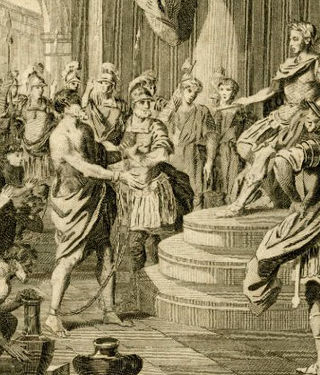
Caratacus was a 1st-century AD British chieftain of the Catuvellauni tribe, who resisted the Roman conquest of Britain.
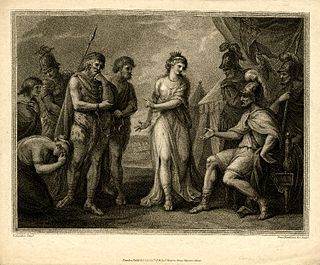
Cartimandua or Cartismandua was a 1st-century queen of the Brigantes, a Celtic people living in what is now northern England. She came to power around the time of the Roman conquest of Britain, and formed a large tribal agglomeration that became loyal to Rome. The only account of her is by the Roman historian Tacitus, through which she appears to have been widely influential in early Roman Britain.

The Iceni or Eceni were an ancient tribe of eastern Britain during the Iron Age and early Roman era. Their territory included present-day Norfolk and parts of Suffolk and Cambridgeshire, and bordered the area of the Corieltauvi to the west, and the Catuvellauni and Trinovantes to the south. In the Roman period, their capital was Venta Icenorum at modern-day Caistor St Edmund.
The Atrebates were a Belgic tribe of the Iron Age and the Roman period, originally dwelling in the Artois region.

The Cantiaci or Cantii were an Iron Age Celtic people living in Britain before the Roman conquest, and gave their name to a civitas of Roman Britain. They lived in the area now called Kent, in south-eastern England. Their capital was Durovernum Cantiacorum, now Canterbury.

Venutius was a 1st-century king of the Brigantes in northern Britain at the time of the Roman conquest. Some have suggested he may have belonged to the Carvetii, a tribe that probably formed part of the Brigantes confederation.
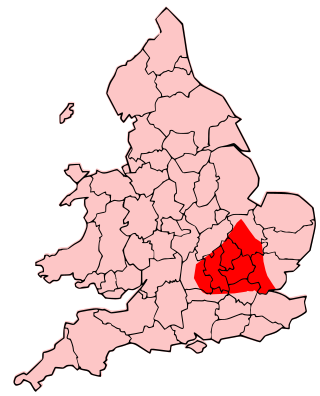
The Catuvellauni were a Celtic tribe or state of southeastern Britain before the Roman conquest, attested by inscriptions into the 4th century.
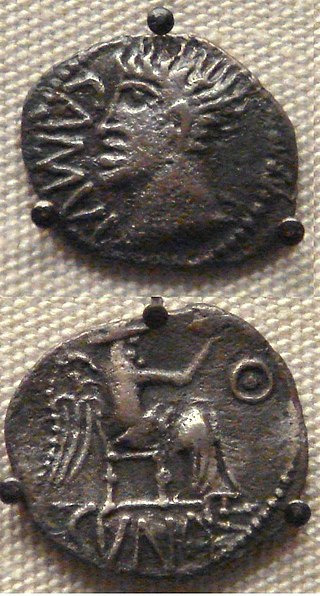
Cunobeline or Cunobelin, also known by his name's Latin form Cunobelinus, was a king in pre-Roman Britain from about AD 9 to about AD 40. He is mentioned in passing by the classical historians Suetonius and Dio Cassius, and many coins bearing his inscription have been found. He controlled a substantial portion of south-eastern Britain, including the territories of the Catuvellauni and the Trinovantes, and is called "King of the Britons" by Suetonius. Cunobeline may have been a client king of Rome, based on the images and legends appearing on his coins. Cunobeline appears in British legend as Cynfelyn (Welsh), Kymbelinus or Cymbeline, as in the play by William Shakespeare.
Togodumnus was king of the British Catuvellauni tribe, whose capital was at St. Albans, at the time of the Roman conquest. He can probably be identified with the legendary British king Guiderius. He is usually thought to have led the fight against the Romans alongside his brother, but to have been killed early in the campaign. However, some authorities now argue that he sided with the Romans and is one and the same person as the client-king Tiberius Claudius Cogidubnus, whose original name may have been Togidubnus or Togodumnus.
Tiberius Claudius Cogidubnus was a 1st-century king of the Regni or Regnenses tribe in early Roman Britain.
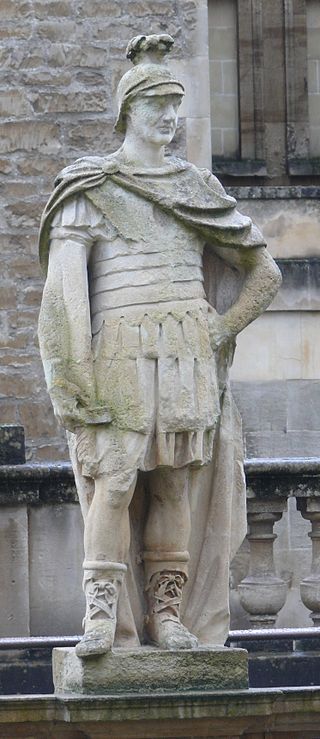
Publius Ostorius Scapula was a Roman statesman and general who governed Britain from 47 until his death, and was responsible for the defeat and capture of Caratacus.
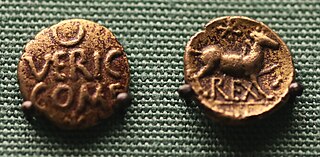
Verica was a British client king of the Roman Empire in the years preceding the Claudian invasion of 43 AD.

Tincomarus was a king of the Iron Age Belgic tribe of the Atrebates who lived in southern central Britain shortly before the Roman invasion. His name was previously reconstructed as Tincommius, based on abbreviated coin legends and a damaged mention in Augustus's Res Gestae, but since 1996 coins have been discovered which give his full name.

Commius was a king of the Belgic nation of the Atrebates, initially in Gaul, then in Britain, in the 1st century BC.
Eppillus was the name of a Roman client king of the Atrebates tribe of the British Iron Age. He appears to have ruled part of the territory that had previously been held by Commius, the Gaulish former ally of Julius Caesar who fled to Britain following the uprising of Vercingetorix, or possibly of his son. Eppillus is not mentioned in any historical sources. Coins bearing his name also bear the inscription COMMI.FILI which is generally read as Commios filius indicating at least a claim to be Commius's son.

The names of the Celtic Iron Age tribes in Britain were recorded by Roman and Greek historians and geographers, especially Ptolemy. Information from the distribution of Celtic coins has also shed light on the extents of the territories of the various groups that occupied the island.
Events from the 1st century in Roman Britain.
This is part of a series on the History of Norfolk















